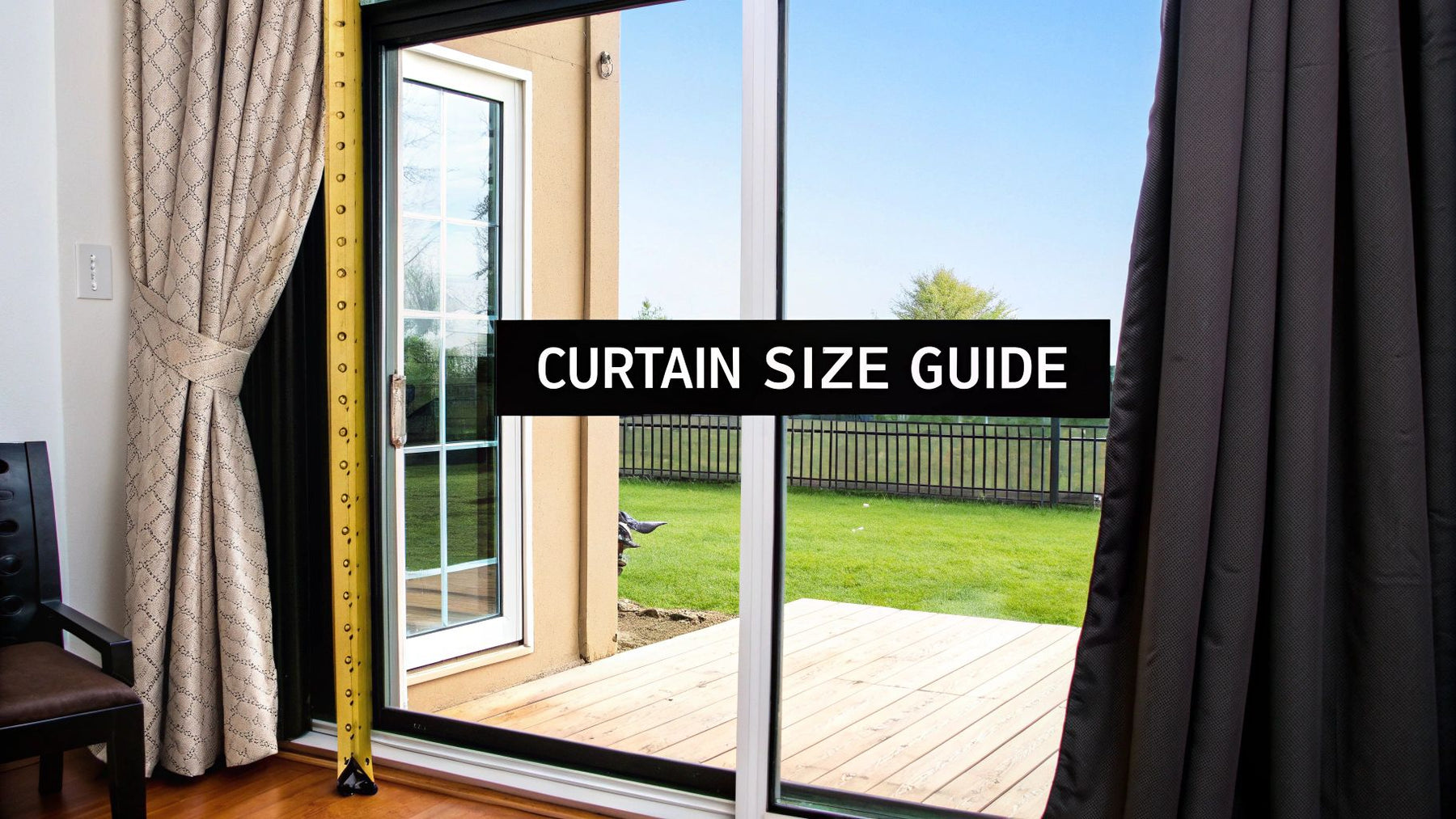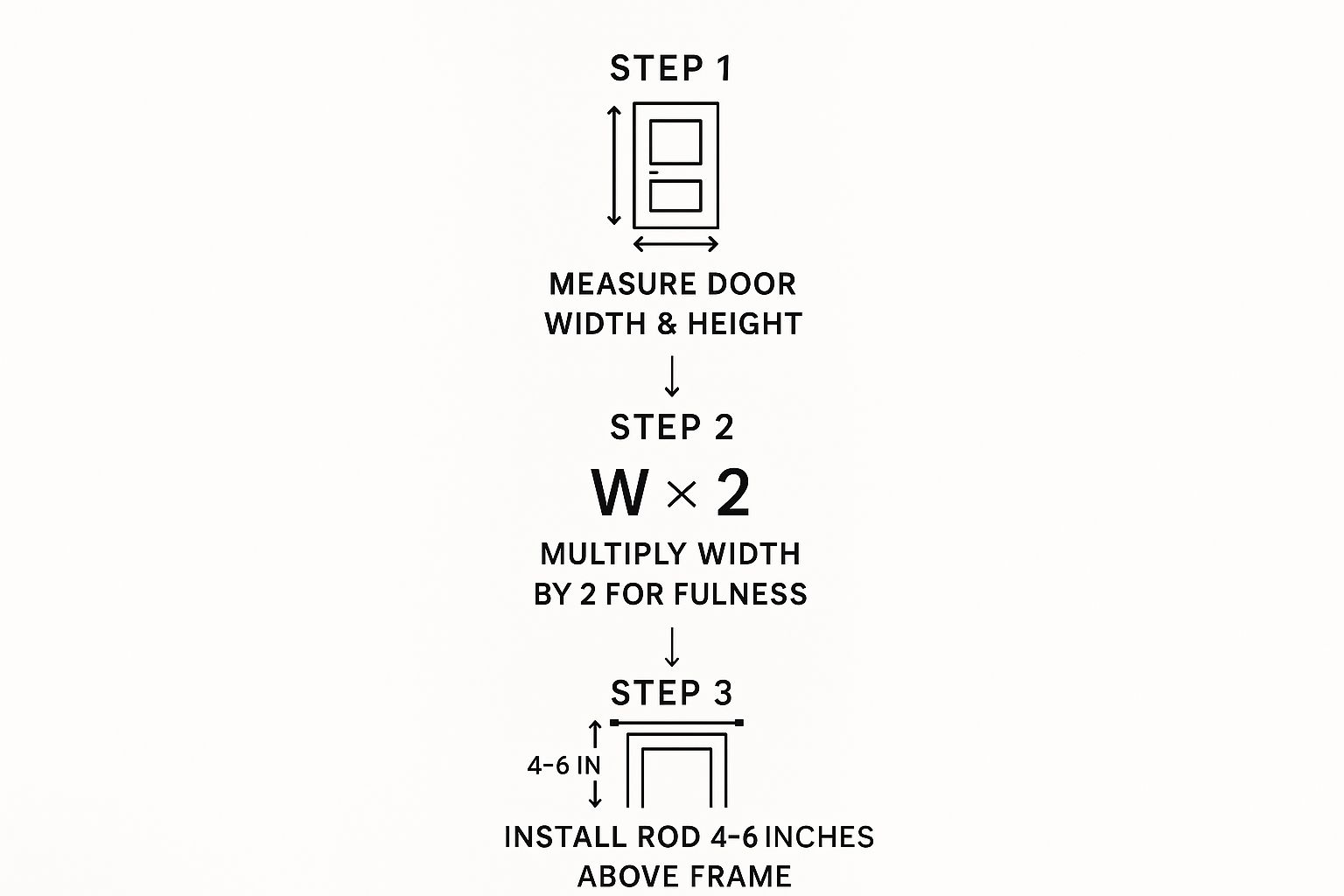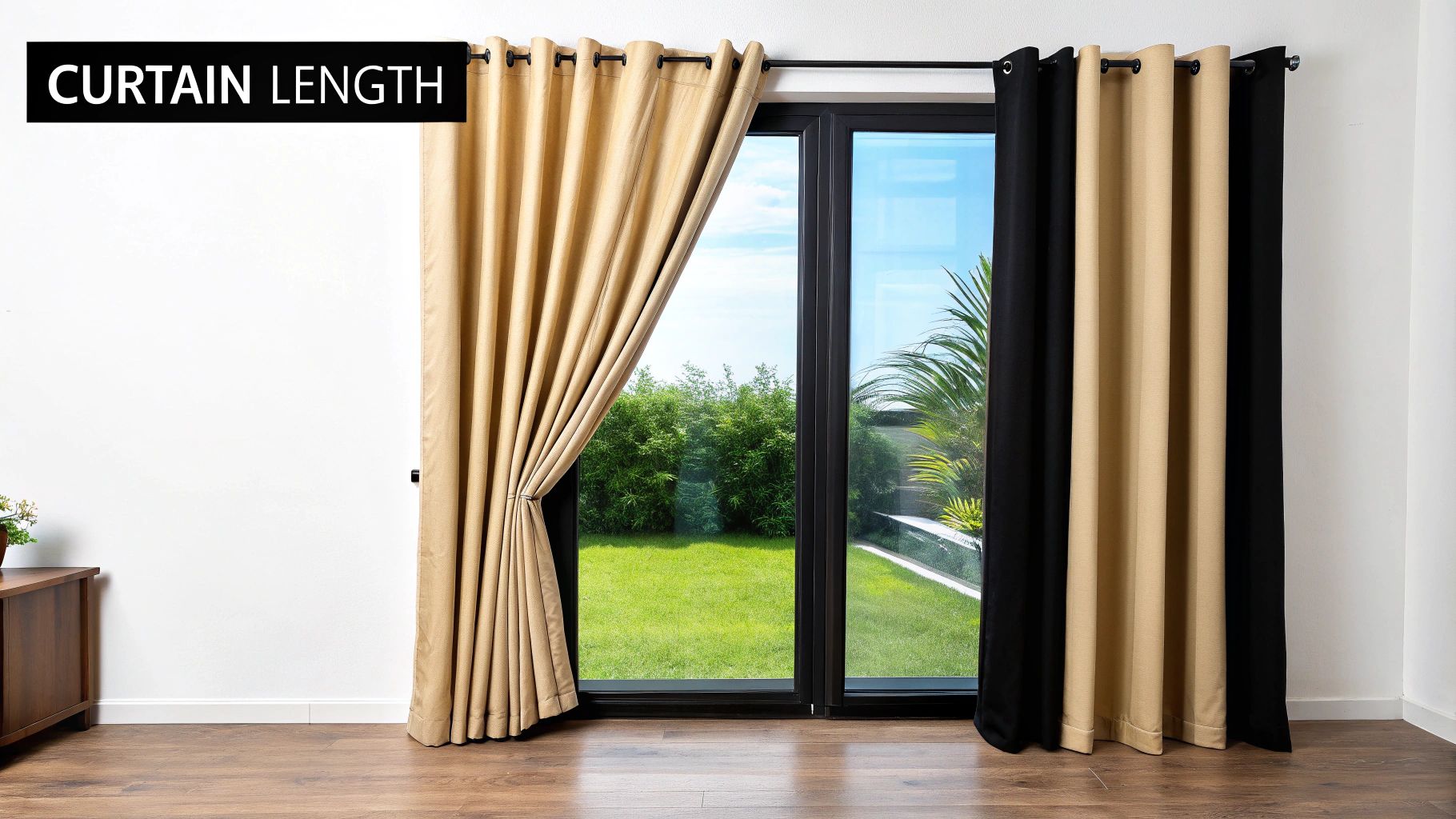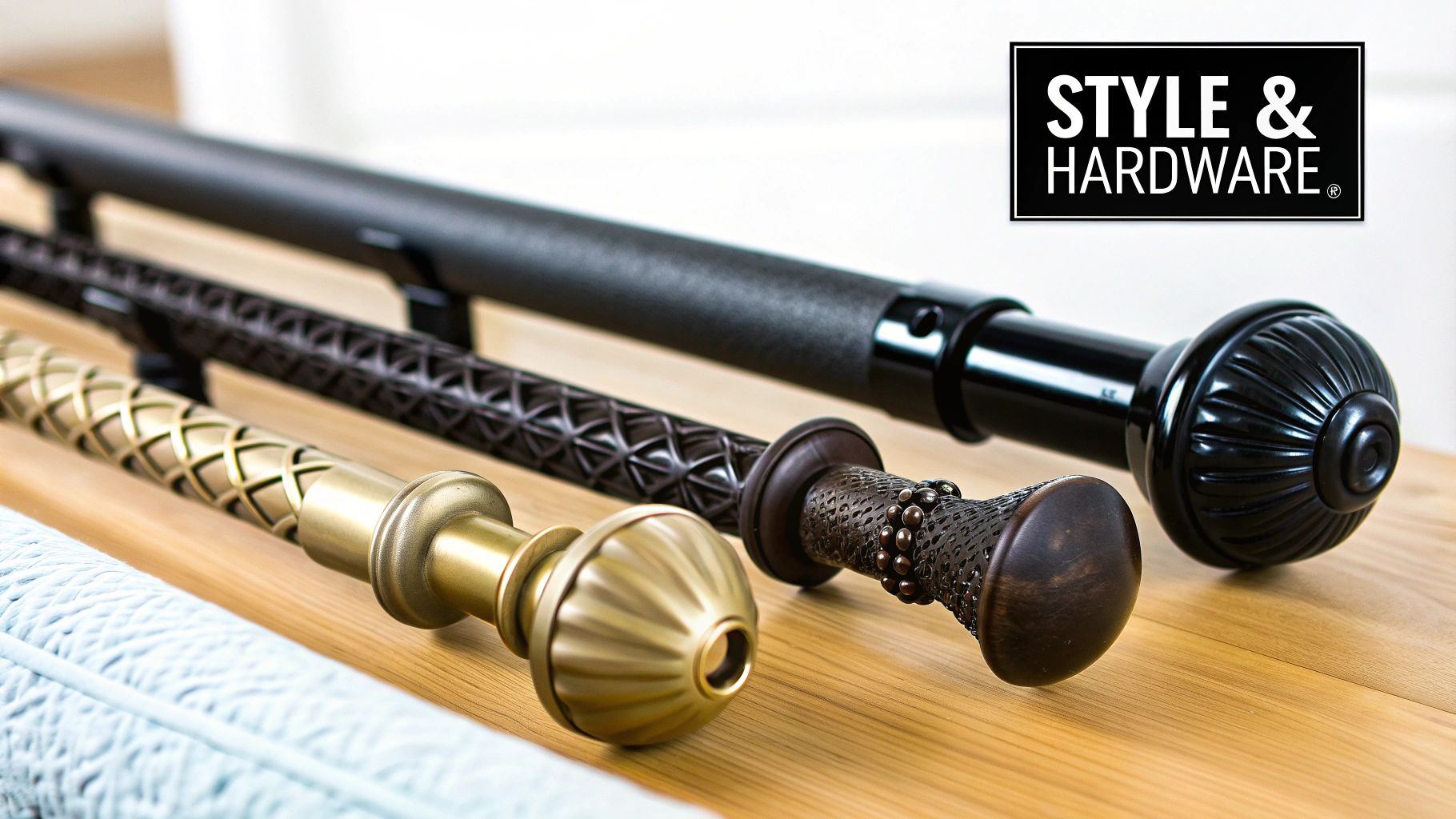
A Guide to the Size of Curtains for Sliding Glass Doors
Choosing the right size of curtains for sliding glass doors is simpler than it seems. The short answer? Your curtain fabric should be at least double the width of your door, and the rod should be mounted 4-6 inches above the door frame. This expert advice is the secret to avoiding flat, sheet-like curtains and achieving a professionally styled, elegant look.
In this guide, we'll walk you through the exact steps to measure for width, choose the perfect length, and avoid common mistakes. Getting this right from the start ensures your new drapes not only look fantastic but function beautifully for everyday life.
Table of Contents
- Why Curtain Sizing Matters
- How to Measure Curtain Width for Fullness and Function
- How to Measure Curtain Length for the Perfect Look
- Choosing the Right Curtain Style and Hardware
- Common Sizing Mistakes and How to Avoid Them
- Frequently Asked Questions
Getting Curtain Sizing Right From The Start
Before you fall in love with a fabric or color, let's get the measurements right. Nailing the size of curtains for sliding glass doors from the get-go saves you from the frustration of returns and the disappointment of an awkward-looking window treatment. It’s all about creating a look that works beautifully and looks even better.
Two key concepts you’ll hear in the design world are fullness and stack back. Let's break them down.
- What is curtain fullness? This is a term for how gathered or pleated your curtains look when they're closed. A classic mistake is buying panels that only match the door's width, resulting in a flat, sheet-like drape. The industry standard, and what we always recommend, is aiming for 2x fullness.
- What is curtain stack back? This refers to the space your curtains take up on the wall when they're pushed all the way open. Without enough stack back, your curtains will block the glass, cutting down on natural light and making your doorway feel smaller.
Understanding Standard Dimensions
The good news is that most sliding glass doors come in standard sizes, which gives us a great starting point. According to data from major manufacturers, a typical sliding glass door in the United States is 80 inches high and either 60 or 72 inches wide.
To get that stack back just right, your curtain rod should extend about 4 to 10 inches beyond the frame on each side. This extra space is crucial because it allows the curtains to clear the doorway completely when you open them up.
This simple infographic breaks down the foundational process for sizing your curtains.

As you can see, getting it right is a three-part formula: measure the door, multiply for fullness, and then mount the rod properly. It’s that easy.
For a little extra help with the measuring tape, feel free to check out our complete curtains measuring guide.
How to Measure Curtain Width for Fullness and Function
The secret to truly beautiful curtains isn't just about the color or fabric—it's all about fullness. Getting the width right is what separates lush, elegant drapes from a sad, flat sheet stretched across your door. This is where you’ll nail down the perfect size curtains for your sliding glass doors to get that polished, professional look.
As a rule of thumb, the industry standard is about 2x fullness. This just means the total width of your curtain panels should be roughly twice the length of your curtain rod. For an 80-inch rod, you’d be looking for around 160 inches of fabric. If you skimp on this, your doorway can look a little sparse and you'll lose some privacy.
To get your measurements spot-on from the start, you'll need the right gear. Grab a good set of essential measuring tools before you do anything else.
Calculating Your Ideal Curtain Width: A Step-by-Step Guide
- Measure the Frame: Use a metal tape measure to find the width of your sliding door frame from one outside edge to the other.
- Add Stack Back: Decide how much space you want for your curtains to rest when open. We recommend adding 4 to 10 inches on each side of the door frame.
- Determine Rod Length: Add the door width and your total stack back space together. This is your final curtain rod length.
- Calculate Fabric Width: Multiply your rod length by a fullness factor to find the total width of the curtain panels you need.
- For a standard, full look: Multiply your rod length by 2.
- For a lighter, more tailored look: Multiply by 1.5.
- For a very rich, luxurious effect: Multiply by 2.5.
Here’s a real-world example: Let's say your sliding glass door is 72 inches wide. You decide to add 8 inches of stack back on each side (that's 16 inches total). Your rod length would be 88 inches (72 + 16). For a standard 2x fullness, you'd need 176 inches of total curtain width (88 x 2).
If math isn't your thing or you're dealing with different window types, a dedicated tool can make life a lot easier. You might find our curtain width calculator really helpful for this step.
How Heading Style Affects Fullness
The type of curtain top, also called the heading, also plays a part in the final look. Different styles use different amounts of fabric to appear properly full and pleated.
- Grommet and Rod-Pocket Curtains: These styles naturally create soft, wide folds as they hang. A 1.5x to 2x fullness factor is usually perfect for them.
- Pinch Pleat Curtains: These have sewn-in pleats that create a more structured, formal appearance. The fullness is essentially built-in, so you typically just need panels that match your rod’s exact width. It's always a good idea to check the manufacturer's notes for these styles, just to be sure.
How to Measure Curtain Length for the Perfect Look
Once you've nailed down the width, it's time to think about the perfect length. This is where the real magic happens, as the length of your curtains can single-handedly shift the entire vibe of a room from casual and relaxed to formal and dramatic. When you're dressing a sliding glass door, getting this right is all about balancing your personal style with how you actually use the door.
The most important tip I can give you is this: always measure from the bottom of your curtain rod down to where you want the fabric to end. Don't make the common mistake of measuring from the top of the door frame. Your rod placement is what truly dictates the final curtain length.

Popular Curtain Length Styles
When it comes to sliding glass doors, there are a few go-to styles that designers and homeowners love, and each one offers a completely different look. While you might see "apron" length curtains that end just below the window frame, they almost never work for doors. They tend to look awkward and can really throw off a room's vertical flow.
Instead, let's focus on the three most stylish and popular choices:
- The Float: This is where the curtains hover about ½ to 1 inch above the floor. It's hands-down the most practical choice for a high-traffic sliding door. You won't have to worry about tripping, the hems stay clean, and opening and closing them is a breeze.
- The Kiss: With this style, the curtains just barely touch, or "kiss," the floor. It creates an incredibly clean, tailored look that feels custom-made and intentional. It does require very precise measuring, but the polished result is absolutely worth the effort.
- The Puddle: For a real touch of luxury and romance, this style has 1 to 3 inches of extra fabric that pools elegantly on the floor. It’s a stunning look, but it’s best suited for formal spaces or doors that don't see a lot of foot traffic, as the fabric can collect dust and be a bit of a hassle.
Insider Tip: Don't forget to account for your hanging hardware! Curtains hung with rings will naturally sit a bit lower than the rod itself, while tab tops might sit higher. This small detail can make a big difference in your final measurement, so it’s always a good idea to decide on your hardware before you finalize the length.
If you want to explore the nuances of each style even further, be sure to check out our complete guide to curtain lengths. It will help you find the perfect fit for any room in your house.
Choosing the Right Curtain Style and Hardware
With your measurements in hand, it's time for the fun part: picking a curtain style and the right hardware to bring your vision to life. This isn't just about looks; the combination you choose will affect how easily you use your sliding door every day. Getting this right is a huge part of finding the perfect curtain size for your sliding glass doors.

Single Panel vs. Double Panels
When it comes to sliding doors, you have two main options. You can go with a single, extra-wide panel. This gives you a clean, modern look, stacking neatly off to one side when it's open. It’s a great choice if your door only opens from one direction.
The more common and practical choice is a pair of two panels that meet in the middle. This creates a beautiful, symmetrical frame for your door and is often way more convenient, especially for high-traffic areas. You can just part them in the center and head outside.
Header Types and Hardware Choices
The very top of the curtain, called the "header," plays a big role in both how the curtains look and how they function.
- Grommet Tops: These are my go-to recommendation for sliding doors. The large metal rings slide so smoothly along a rod, which is exactly what you want for a door you're opening and closing all the time.
- Rod Pockets: This is the classic style where a sleeve of fabric just slides onto the rod. It's a simple look, but they can sometimes snag or be a bit fussy to move back and forth.
For hardware, a simple decorative rod is a solid choice. But if you want the ultimate in convenience, I'd seriously consider a traverse rod. These use a little wand or a cord to open and close the curtains for you. It's a small luxury that keeps fingerprints off your beautiful fabric and prevents wear and tear over time.
To help you decide, here’s a quick breakdown of the most common styles for sliding glass doors.
Curtain Style Comparison for Sliding Doors
| Curtain Style | Pros | Cons | Best For |
|---|---|---|---|
| Grommet Top | Easy to slide open/close; modern look. | Metal rings can be noisy; less formal. | High-traffic doors and contemporary decor. |
| Rod Pocket | Classic, simple appearance; budget-friendly. | Can be difficult to slide smoothly. | Doors that are not used frequently; casual spaces. |
| Back Tab | Clean, pleated look from the front. | Can be stiff to move along the rod. | Creating a tailored look with less frequent use. |
| Traverse Rod | Effortless opening with a wand/cord. | More complex installation; can be pricey. | Very wide doors or for ultimate convenience. |
Each style brings something different to the table, so think about how often you'll be using the door when making your choice.
If light control and energy efficiency are high on your list, you’ll want to explore a good set of blackout or thermal curtains. They're amazing for privacy, blocking harsh sunlight, and even providing some insulation to help with your energy bills.
Common Sizing Mistakes and How to Avoid Them
Even with the best of intentions, it’s surprisingly easy to get curtain measurements wrong. Getting the size of curtains for sliding glass doors right the first time saves you a world of frustration. Let's walk through the most common blunders I’ve seen so you can sidestep them like a pro.
One of the biggest errors is completely forgetting to account for stack back. This is just a simple term for the space your curtains take up on the wall when they're pushed all the way open. If you only measure the door itself, your beautiful new curtains will end up blocking a chunk of the glass and the walkway. It defeats the whole purpose of having that big, light-filled door.
Another frequent misstep is measuring only the door frame to figure out the curtain width. This always leads to panels that look stretched thin and skimpy when you close them. You lose that desirable, elegant fullness that makes curtains look so good.
Nailing the Measurements Every Time
Luckily, the fix for these problems is simple but absolutely critical.
- Extend your rod: Always plan to extend your curtain rod 4 to 10 inches beyond the door frame on each side. This extra space is your dedicated stack back zone, and it's what ensures the curtains can clear the glass completely when you open them.
- Multiply for fullness: When you're calculating the width, measure the entire rod length (including those extensions), not just the door. Then, take that total number and multiply it by at least 1.5 to 2 to get the final fabric width you need.
Pro Tip: Always, and I mean always, use a firm, metal measuring tape. Those soft, fabric ones can stretch or sag, throwing your numbers off just enough to cause a headache. And the oldest rule in the book still stands: measure twice, order once.
By keeping these practical, experience-based tips in mind, you can avoid costly mistakes and hang your curtains with the confidence of someone who's done it a hundred times. It’s not about complex formulas—it's just about thoughtful planning.
Frequently Asked Questions
Here are direct answers to the most common questions we get about the size of curtains for sliding glass doors.
What is a good size for curtains for a sliding glass door?
For a standard 72-inch wide sliding door, a good size is two curtain panels that are each 75-80 inches wide. This provides the recommended 2x fullness for a lush look. For length, 84 inches is a standard size that works well if your rod is mounted about 4 inches above the 80-inch tall door frame.
Should you use one or two curtain panels for a sliding glass door?
We almost always recommend using two curtain panels. This creates a symmetrical, balanced look that frames the door beautifully. It's also far more practical for a high-traffic door, as you can easily part the curtains in the middle to go in and out. A single panel can look unbalanced and be cumbersome to operate daily.
How high above a sliding glass door should you hang curtains?
You should hang your curtain rod 4 to 6 inches above the top of the door frame. Hanging the rod higher draws the eye upward, creating the illusion of taller ceilings and a more spacious, elegant room. Avoid mounting the rod directly on the door trim, as this can make the space feel smaller.
What is the most functional type of curtain for a sliding glass door?
For a door that gets a lot of use, grommet-top curtains are the most functional choice. The large metal rings slide effortlessly along the rod, making them easy to open and close. For ultimate convenience, curtains operated by a traverse rod are a game-changer, as they open with a simple pull of a wand or cord.
At Joey'z Shopping, we believe finding the perfect window treatments should be simple and satisfying. Explore our full collection of stylish and functional curtains today to find the ideal match for your home.
